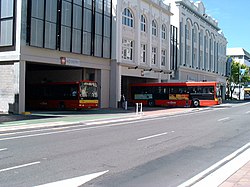 | |
 The new Bus Interchange in August 2015 | |
| Locale | New Zealand |
|---|---|
| Service area | Christchurch |
| Service type | Bus services |
| Annual ridership | 14.5 million (2023/24) [1] |
| Fuel type | Diesel, biodiesel, electric |
| Operator | Ritchies Transport Go Bus Christchurch Black Cat Ltd [2] |
| Website | www |



Public transport in Christchurch, New Zealand, consists primarily of bus services operated by two bus companies supported by a ferry, all jointly marketed as Metro, a division of Environment Canterbury (ECan).
Contents
- Overview
- Operations
- Bus interchange
- Riccarton Road lounge
- Bus services
- High frequency services
- City Connector services
- Suburban Link services
- Bikes on buses
- Future
- PT Futures
- Mass Rapid Transit (MRT)
- Motu Move
- Other transport services
- Taxis
- Airport transport
- Diamond Harbour ferry
- Christchurch Tramway
- Heavy rail
- References
- External links
Metro also operates the MyWay on-demand bus service in Timaru, Canterbury. [3] Prior to 2023, it also operated various fixed-route bus services in Timaru. [4] In 2020, it began trials of its MyWay service. [5]







